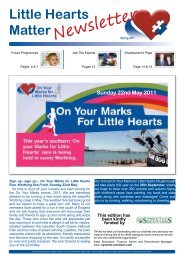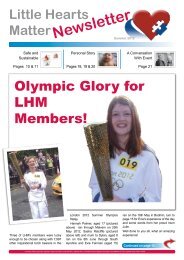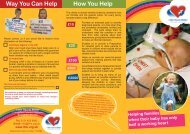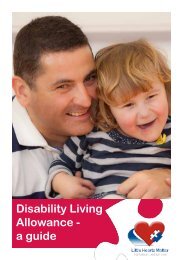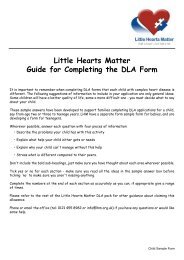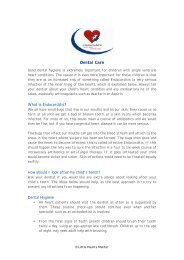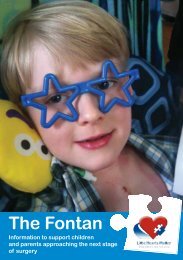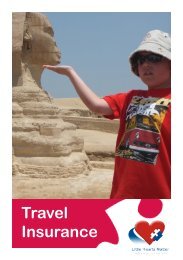here - Little Hearts Matter
here - Little Hearts Matter
here - Little Hearts Matter
- No tags were found...
Create successful ePaper yourself
Turn your PDF publications into a flip-book with our unique Google optimized e-Paper software.
2122 LHEARTS 20PP:NewsletterNo2 2009.qxd 05/11/2009 10:06 Page 16Zipper ZoneJon gives an overview on some of the things he has beenworking on with our young members.Written byJon BrunskillYouth Development OfficerAlways start with a joke...Through the pitch-black night, the captain sees a light dead ahead on a collision course with his ship.He sends a light-signal to the approaching ship: "Change your course 10 degrees east."The light signals back: "No, you change your course 10 degrees west."Angry, the captain sends: "I'm a navy captain! Change your course, sir!""I'm a seaman, second class," comes the reply. "Change your course, sir."Now the captain is furious. "I'm a battleship! I'm not changing course!"T<strong>here</strong> is one last reply. "I'm a lighthouse…Your call."16Now for the serious stuff...Together, we can make a difference forall children with half a heart, and for allof the children in the future.Please help us to help them.Dear parents,Recently you will have received a letter from meexplaining about a research project that <strong>Little</strong><strong>Hearts</strong> <strong>Matter</strong> is undertaking. I know that youwould probably like some more information onwhy this project is taking place, who will benefit,and how you can help? I'd like to use this spaceto answer these questions, and explain howimportant it is that we have as many people aspossible taking part in this project.Why is this project being undertaken?In short, to help us identify exactly which issuesare important to the 10-18 age group and howthese young people feel about these issues.We all know that life can get tough for familieswith a child with a single ventricle heart condition.Many parents contact us after experiencingproblems with their child's school or teachers, orit could be that you are having troublecommunicating with your child's doctor at theconsultancy meetings. Life can be frustrating forthe young people too. At an age of naturalboundary pushing they have to be taught thattaking risks can have much more severeconsequences than with 'normal' children. Whenyou are a teenager, all you want to be is thesame as everybody else.The challenge that we all face is trying to gaina solid understanding of the young person'sheart condition, and how having it affects them.Only then can we provide the best services tohelp give the children the support and guidancethat they need and deserve.‘How I Feel’ is the research project that willaddress some of the most pertinent issuesaffecting the 10-18 age group. It will find outexactly how the children feel about day to dayissues. This questionnaire based study will askthe children to voice their feelings on seventopics:Hospital and MedicationFamily and FriendsSchoolFeelings and…stuffBig Kids (For teenagersaged 13 and above)Sports and ActivitiesDiet and FoodThis will not only give us a much betterunderstanding of the children's needs, it will giveus a quantified piece of evidence that can beused to influence medical and healthcareprofessionals. This piece of evidence will alsogive LHM a much louder voice when lobbying forchange on issues such as paying forprescriptions once the children reach adulthood.How did we create the questionnaire?Suzie and I have been working very closely withthe young people at various events over the lastfew years to engage with them on which issuesare important to them. Earlier this year, weestablished a Youth Council which has been veryvocal in identifying the needs of young peoplewith a single ventricle heart disease.We also sought input from the medicalprofessionals who work with these youngpeople, including a clinical psychologist. All ofthese inputs combined with years of anecdotalevidence have meant that we have been able tocreate a concise questionnaire addressing themost important issues which need to beaddressed as soon as possible.The questionnaire should take between 30and 60 minutes to complete.What is the video stage?Most questions in the questionnaire are tickboxes so that the data can be quantified andpresented as statistics. The participants maywish, however, to elaborate on a particular issuebeyond the constraints of the questions. Theywill be given the opportunity to do this in an'interview' scenario with a facilitator, who will gothrough the young person's questionnaire withthem to give them a chance to talk about theirspecific feelings on an issue. These feelings willbe transcribed and used in the final evaluation toadd weight and a human element to thestatistics. No names will be attributed to thequotes in the evaluation process. if you or yourchild wish, the footage will be destroyed as soonas it has been transcribed.The footage may be used when presentingthe results of the study. Explicit and writtenconsent from both you and your child will besought if this avenue is chosen.Who will benefit from this questionnaire?T<strong>here</strong> will be both short term and long-termbenefits that will come from the outcomes of thisproject. <strong>Little</strong> <strong>Hearts</strong> <strong>Matter</strong> will be able to use theinformation gat<strong>here</strong>d and immediately apply it toour service provision, giving tailor-made support



